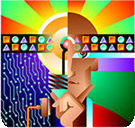|
WHAT
IS SYSTEM DYNAMICS?
System
dynamics is a field of study that Jay Forrester founded at
the Massachusetts Institute of Technology (MIT) in the 1950s.
The field has a long history, and has drawn from other fields
as diverse as mechanical engineering, biology, and the social
sciences.
In
its simplest sense, system dynamics focuses on the flow of
feedback (information that is transmitted and returned) that
occurs throughout the parts of a system—and the system
behaviors that result from those flows. For example, system
dynamicists study reinforcing processes—feedback flows
that generate exponential growth or collapse—and balancing
processes—feedback flows that help a system maintain
stability.
These
reinforcing and balancing processes really aren't mysterious—they're
all around us and within us. The world population explosion,
the U.S. stock market crash of the 1930s, and the sudden onset
of disease when foreign microbes proliferate in our bodies
are all examples of reinforcing cycles. Our bodies' ability
to maintain a basic temperature of 98.6 degrees Fahrenheit,
the stability that occurs in predator/prey systems, and the
difficulty we often face when we try to change the way our
organization does things are all examples of balancing cycles.
In
addition, system dynamicists study the impact of delay on
systemic behavior. Specifically, what are the implications
when a cause takes a long time to exert its effect, and when
cause and effect are physically far apart? For example, if
your organization raises prices on its products beyond the
comfort level of your customers, it may take a while for customers
to get fed up and stop buying. If it takes a really long time
for you to notice this feedback, you may not realize that
customer buying habits are connected to the price hike you
instituted "way back when." (In fact, you might
even panic about declining revenues and hike prices up even
higher to try to save the business!)
Perhaps
the most exciting thing about system dynamics is that it focuses
on computer simulation modeling—using special software
programs to figure out how a system's behavior might play
out over time if you implement certain changes. Simulation
models are often embedded in what are known as "management
flight simulators" or "microworlds," computer
programs with accessible user interfaces that let you "test
flight" your ideas—without crashing your business!
The
field of system dynamics gave rise to and serves as the bedrock
for the field of systems thinking.
What's the difference between the two? With its emphasis on
simulation modeling, system dynamics is generally seen as
the more rigorous, academic field—though many management
consultants use computer models in their work with clients.
Systems thinking takes the principles of systemic behavior
that system dynamics discovered—and applies them in practical
ways to common problems in organizational life. In fact, simulation
modeling, management flight simulators, and microworlds are
merely some of the tools used by systems thinkers to understand
the world around them and address problems.
Together,
these two fields can become a potent ally as you navigate
your way through the sometimes rocky terrain of organizational
life!
|



